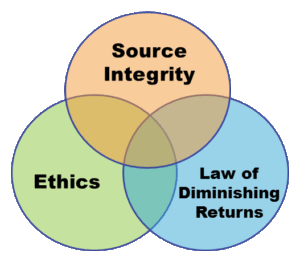 In prospect research, the rule-of-thumb has always been to find at least one, and preferably two, corroborating sources for information found on a prospect. With the onrush of data, technology, and some of humanity’s evil proclivities, could that rule-of-thumb all too easily turn into a sore thumb?
In prospect research, the rule-of-thumb has always been to find at least one, and preferably two, corroborating sources for information found on a prospect. With the onrush of data, technology, and some of humanity’s evil proclivities, could that rule-of-thumb all too easily turn into a sore thumb?
The idea that completely fake stories circulate on the internet in pursuit of clicks and the resulting ad revenue – and that these stories are obscenely successful – makes me feel like I’ve reached for my wallet to pay for a meal only to discover my purse was stolen. At some point in our lives, most of us have done a quick Google search to answer a question and have taken the results at face value without clicking through to more carefully verify. I’ve certainly done it.
As the prospect profile shapeshifts in response to really good aggregators and an on-demand, as-needed approach to fundraising, could we be duped by perniciously false or even simply erroneous information?
I’d like to believe that prospect research professionals already go beyond the corroborating source rule-of-thumb and consider the quality and reputation of the source, the date, and the sensitivity of the information, especially when there appears to be a lot of value-laden words or outright bias.
A simple example of this is a Wikipedia article. While Wikipedia provides a nice summary, clicking through the article’s sources and reading the original cite is critical. Another example that came up recently on the Apra PRSPCT-L list-serv was evidence of a criminal record.
Sources such as Lexis Nexis for Development Professionals allow us to see certain criminal records. Sometimes we find news articles, court documents published on attorney websites, and other sources, too. We worry about the risk to our organization’s reputation and whether the information will impact a prospect’s ability and interest in making a gift. But understanding the process for convicting someone and finding all the information can be a time-consuming, complex task.
In addition to complex information such as a criminal offense, we now face completely false information in our quest to better understand our prospects. Right now I can feel a whole day slip away trying to research a false news story… can we efficiently and deliberately navigate this mine field?
Yes we can…but only if we have a Venn diagram!

There are three key competing demands as we evaluate the information we find:
- Source Integrity: Most of us are pretty good at this. We know that the government is likely to be a more credible source than an industry blog. We also look for corroborating sources, dates, and even the language used.
- Ethics: Apra (the Association of Prospect Researchers for Advancement) as well as AFP (Association of Fundraising Professionals) both have guidance on ethics. Your organization probably has policies and documentation on gift acceptance, prospect management, and more that can help you make decisions.
- Law of Diminishing Returns: As we chase the details of any piece of information there comes a point where further research is without value. You might not need to know all the exact details about a criminal offense to make a decision about a prospect. Knowing when to stop is tricky. Ask for help!
All of these three items overlap to find the sweet spot for dealing with prospect information. It doesn’t matter if you are finding quick information before a visit, verifying a prospect screening, or digging deeper during cultivation and solicitation. Questioning sources is just as important as it ever was.
Consider this: voice recognition is getting so good that with enough recorded voice to learn from, machines can fabricate new audio recordings that sound exactly the real person. Next up? Completely fabricated videos.
The rapid pace of technology is enough to cause alarm! It’s comforting to remember that we have the fundamentals, such as the three elements of the Venn diagram above. All we need to do is stay aware and apply them to the ever-changing online world.
More Resources
- How to Spot Fake News | International Federation of Library Associations and Institutions (IFLA)
- PBS News Hour Column: Can librarians help solve the fake news problem?
- (Free) Course: Sources, Verification and Credibility | Poynter Institute
- (Free) Webinar: Post-Truth: Fake News and a New Era of Information Literacy | American Library Association
- ($29.95) Webinar: Don’t Get Fooled Again: Best Practices for Online Verification | Poynter Institute
Related to the problem of fake news is the tendency of online “news” sources to simply copy what another source has said without verifying the information independently. Many of us have seen information in an online source that is incorrect, and then over a period of weeks and months seen that same incorrect information copied verbatim in a number of other sources. So not only is it important to corroborate information, but it’s important to make sure that your second or third sources really are independent of your first source.
Sage advice, Deborah! I recall reading about a grad student’s experiment on Wikipedia. He entered some fictional information and the media picked it up very quickly. Wikipedia flagged and corrected the information in their normal editing course, but it was too late. The grad student contacted the media outlets and informed them of the fictional nature and some didn’t bother to correct the error. Digital danger!